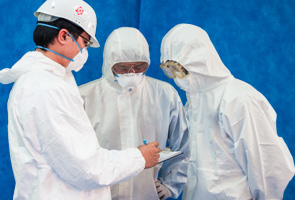
Type 6b coverall

| Name | Protective Coverall |
|---|---|
| Designed to protect wearers against heavy liquid splash with Type 5, Type 6 and EN 14126 certification. | |
| Color | White. |
| Applications | Agriculture, automobile industry, disaster management, electronics industry, pharmaceuticals, petrochemicals. |
| Treatment |

![]()
![]()
![]()
![]()
![]()
![]()
![]()
![]()
![]()
![]()
![]()
![]()
![]()
![]()
![]()
![]()
An Effective Barrier Against Blood, Body Fluids and Infective Agents
The fabric performance exceeds both WHO protective clothing specification Option 1 & 2 for Ebola Virus Disease Infection Control. [Note*]
Note*: The WHO recommended specification for coveralls against filovirus disease issued in Oct, 2014 stated that healthcare workers should choose appropriate protective apparel, which meets the following two requirements:
option 1, tested for resistance to blood and body fluid penetration: meets or exceeds ISO 16603 class 3 exposure pressure.
option 2, tested for resistance to blood-borne pathogen penetration; meets or exceeds ISO 16604 class 2 exposure pressure.
Proven Protection of Fabric Performance Against Blood or Body Fluids
Meets Class 6 for ISO 16603 (Resistance to penetration by blood or fluids) under CE Standard EN 14126 (Against infective agents).
Proven Protection of Fabric Performance Against Blood-borne Pathogens
Meets Class 2 for ISO 16604 (Resistance to penetration by blood-borne pathogens) under CE Standard EN 14126 (Against infective agents)
Proven Protection of Fabric Performance Against Liquid Aerosol
Meets Class 3 for ISO/DIS 22611 (Resistance to liquid aerosol penetration) under CE Standard EN 14126 (Against infective agents).
Breathable to Work Efficiently
Designed for comfort use. Allow wearers to work efficiently while releasing their body heat to prevent heat exhaustion.
When dealing with hazardous materials will purpose personal protective equipment that has to be essential to protect the right way. All of the Coveralls have a different standard to respond to different resistance to many workplace hazards.
Type 5 is protection against airborne particles that can protect the wearer against dust and dry particles. there are also suitable for asbestos and silica protection. When dealing with hazardous materials such as asbestos and silica dust, it is important that workers have completed risk assessments and are wearing the correct clothing to avoid the risk of contamination.
Moreover, type 6 is protection against liquid chemical splashes that can protect the wearer against light spray and splashes. They are similar to Type 3 and Type 4 suits however they are tested with a light spray of liquid which is not permitted to build up on the suit.




